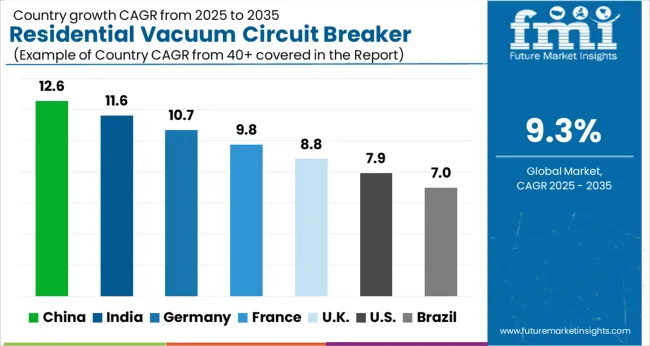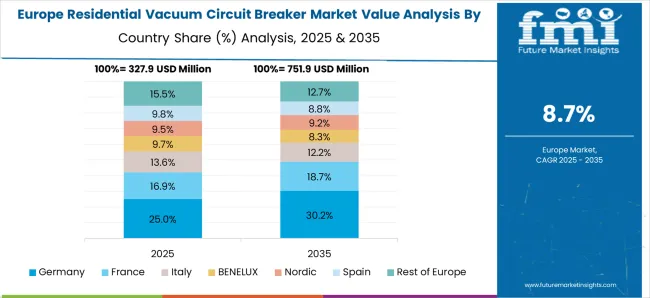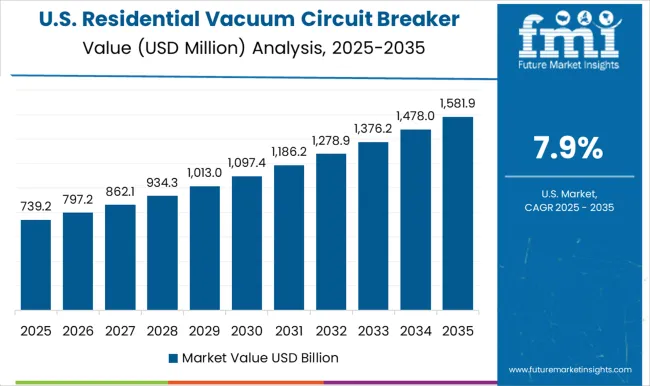The residential vacuum circuit breaker market is projected to grow from USD 1.4 billion in 2025 to USD 3.5 billion by 2035, generating an absolute dollar opportunity of USD 2.1 billion over the forecast period. This growth, supported by a CAGR of 9.3%, is driven by the increasing demand for electrical safety and reliability in residential applications, as the need for modern, high-efficiency electrical systems rises. In the first five-year phase (2025–2030), the market is expected to grow from USD 1.4 billion to USD 2.3 billion, adding USD 0.9 billion, which accounts for 42.9% of the total incremental growth.
The second phase (2030–2035) will contribute USD 1.2 billion, representing 57.1% of the total growth, reflecting stronger momentum from increasing demand in smart homes, renewable energy systems, and government incentives for energy-efficient appliances. Annual increments will rise from USD 0.2 billion in early years to USD 0.4 billion by 2035, signaling a more rapid growth due to technological advancements, the rise of electric vehicles, and greater emphasis on energy security. Manufacturers focusing on intelligent, eco-friendly, and cost-effective circuit breakers will capture the largest share of this USD 2.1 billion opportunity.
| Metric | Value |
|---|---|
| Residential Vacuum Circuit Breaker Market Estimated Value in (2025 E) | USD 1.4 billion |
| Residential Vacuum Circuit Breaker Market Forecast Value in (2035 F) | USD 3.5 billion |
| Forecast CAGR (2025 to 2035) | 9.3% |
The residential vacuum circuit breaker market is experiencing sustained growth due to increasing investments in residential infrastructure, rising electrification rates, and a growing focus on safety and energy efficiency. Urbanization and smart city developments have accelerated the need for advanced circuit protection solutions capable of managing electrical faults effectively in domestic settings.
Vacuum circuit breakers are increasingly preferred for their durability, arc quenching efficiency, and minimal maintenance requirements. Their compact size, long operational life, and suitability for high-frequency operations make them ideal for residential applications.
Regulatory emphasis on electrical safety codes, coupled with consumer awareness about fire prevention and voltage surge protection, is further driving adoption. The future outlook remains strong, supported by consistent demand from emerging economies and the integration of circuit protection in smart homes and renewable energy installations.
The residential vacuum circuit breaker market is segmented by rated current, installation, and geographic regions. By rated current of the residential vacuum circuit breaker market is divided into 60 A, 60 - 100 A, and > 100 ALFA. In terms of installation of the residential vacuum circuit breaker market is classified into Indoor and Outdoor. Regionally, the residential vacuum circuit breaker industry is classified into North America, Latin America, Western Europe, Eastern Europe, Balkan & Baltic Countries, Russia & Belarus, Central Asia, East Asia, South Asia & Pacific, and the Middle East & Africa.
The 60 A segment is anticipated to account for 39.60% of the total market revenue by 2025 within the rated current category, making it the leading segment. This dominance is driven by its suitability for standard household electrical loads and its ability to ensure stable performance in diverse residential wiring configurations.
The 60 A rating provides a balanced solution for safety and operational efficiency without the need for high-capacity industrial specifications. Its compatibility with typical home appliances and lighting systems, along with ease of installation and lower cost, has encouraged widespread adoption.
As residential construction continues to rise, especially in urban and semi-urban areas, the 60 A category remains the preferred choice for ensuring safe and efficient power distribution across homes.
The indoor segment is projected to contribute 57.30% of total market revenue by 2025 under the installation category, positioning it as the dominant segment. This growth is attributed to the increasing demand for space-saving, enclosed, and tamper-proof electrical solutions in residential complexes.
Indoor vacuum circuit breakers are favored for their enhanced protection against environmental exposure, reduced maintenance needs, and ease of integration within residential panels and cabinets. Additionally, the rise in multi-family dwellings and apartment-based infrastructure has created a strong requirement for reliable indoor installation systems.
With growing awareness about safety and structured cabling in residential settings, indoor systems continue to lead due to their practicality, longevity, and seamless fit into modern home electrical layouts.
The residential vacuum circuit breaker market is driven by the increasing demand for safer electrical systems, expanding residential construction, and the rise of smart homes. Emerging trends such as compact and high-efficiency designs are reshaping the market, while challenges like high initial costs and installation complexity remain. By 2025, addressing these challenges through cost-effective solutions and simplifying installation will be key to enabling broader adoption and ensuring the continued growth of the market.
The residential vacuum circuit breaker market is experiencing growth driven by the increasing demand for safer and more efficient electrical systems. As residential infrastructure expands, there is a growing focus on ensuring electrical safety, particularly in high-rise buildings and densely populated areas. Vacuum circuit breakers offer several advantages over traditional circuit breakers, such as faster interruption times and better arc-quenching capabilities. By 2025, the demand for these advanced safety solutions will continue to rise, fueling the growth of the residential vacuum circuit breaker market.
Opportunities in the residential vacuum circuit breaker market are growing with the expanding residential construction and the rise of smart homes. As more new homes are built and existing ones are retrofitted with smart technologies, there is an increased need for efficient, reliable, and safe electrical systems. Vacuum circuit breakers, which offer better performance and protection, are well-suited for integration into these modern electrical systems. By 2025, the integration of advanced electrical solutions in residential homes will drive demand for vacuum circuit breakers.
Emerging trends in the residential vacuum circuit breaker market include the development of compact and high-efficiency models. These breakers are being designed to take up less space while maintaining the same high level of performance and safety. The need for space-efficient solutions in modern residential buildings is pushing the market toward more compact designs. By 2025, these trends will continue to gain traction, as homeowners and developers seek electrical systems that provide maximum protection without compromising on space or energy efficiency.
Despite growth, challenges such as high initial costs and installation complexity persist in the residential vacuum circuit breaker market. The cost of vacuum circuit breakers is generally higher than that of traditional breakers, which may limit their adoption in cost-sensitive residential projects. Additionally, the installation of vacuum circuit breakers requires specialized knowledge and expertise, further increasing costs. By 2025, overcoming these challenges through cost reduction strategies and more straightforward installation processes will be critical for increasing the adoption of these devices in residential settings.

| Country | CAGR |
|---|---|
| China | 12.6% |
| India | 11.6% |
| Germany | 10.7% |
| France | 9.8% |
| UK | 8.8% |
| USA | 7.9% |
| Brazil | 7.0% |
The global residential vacuum circuit breaker market is projected to grow at a 9.3% CAGR from 2025 to 2035. China leads with a growth rate of 12.6%, followed by India at 11.6%, and Germany at 10.7%. The United Kingdom records a growth rate of 8.8%, while the United States shows the slowest growth at 7.9%. These varying growth rates are driven by factors such as increasing demand for reliable and efficient residential electrical systems, the rising adoption of clean energy technologies, and government initiatives to improve energy efficiency in residential sectors.
Emerging markets like China and India are experiencing higher growth due to rapid industrialization, urbanization, and infrastructure development, while more mature markets like the USA and the UK see steady growth driven by technological advancements, regulatory frameworks, and growing demand for reliable residential power solutions. This report includes insights on 40+ countries; the top markets are shown here for reference.
The residential vacuum circuit breaker market in China is growing rapidly, with a projected CAGR of 12.6%. China’s rapidly expanding residential and commercial infrastructure, combined with the growing demand for reliable and energy-efficient electrical systems, is driving significant demand for vacuum circuit breakers. The country’s strong investments in energy infrastructure, coupled with government initiatives to improve energy efficiency and reduce carbon emissions, further contribute to the adoption of vacuum circuit breakers in residential applications. Additionally, the increasing focus on smart grid technologies and the integration of renewable energy sources into the residential power grid further accelerates market growth.
The residential vacuum circuit breaker market in India is projected to grow at a CAGR of 11.6%. India’s increasing residential energy consumption, rapid urbanization, and growing demand for reliable and efficient electrical systems are key drivers of market growth. The country’s ongoing infrastructure development, combined with government policies promoting energy-efficient solutions, continues to fuel the adoption of vacuum circuit breakers in residential applications. India’s growing middle class and increasing awareness of the benefits of energy-efficient electrical systems further contribute to the market’s expansion. The push for smart cities and sustainable infrastructure projects in India continues to support the demand for advanced electrical solutions like vacuum circuit breakers.

The residential vacuum circuit breaker market in Germany is projected to grow at a CAGR of 10.7%. Germany’s demand for vacuum circuit breakers is driven by the growing need for energy-efficient and reliable electrical systems in residential and commercial buildings. The country’s commitment to sustainability, energy efficiency, and reducing carbon emissions continues to fuel the market’s growth. Additionally, Germany’s focus on integrating renewable energy sources into residential grids and its push for smart infrastructure in urban areas contribute to the adoption of vacuum circuit breakers. Regulatory frameworks promoting energy-efficient electrical systems in homes further accelerate the demand for advanced solutions like vacuum circuit breakers.
The residential vacuum circuit breaker market in the United Kingdom is projected to grow at a CAGR of 8.8%. The UK’s increasing focus on improving energy efficiency, along with its strong commitment to reducing carbon emissions, is driving steady market growth. The country’s investments in renewable energy and smart grid technologies, as well as its emphasis on modernizing residential electrical infrastructure, are contributing to the demand for vacuum circuit breakers. Additionally, government incentives for adopting energy-efficient electrical systems in residential buildings, coupled with a growing interest in reducing energy consumption, further accelerates the adoption of vacuum circuit breakers.

The residential vacuum circuit breaker market in the United States is expected to grow at a CAGR of 7.9%. The USA market is driven by the increasing demand for energy-efficient and reliable power solutions in residential homes. The growing adoption of smart home technologies, along with the rising focus on reducing energy consumption and carbon emissions, is contributing to the demand for vacuum circuit breakers. Additionally, USA regulatory policies promoting energy efficiency, along with growing investments in smart grid systems and renewable energy solutions, continue to support market growth. The need for reliable backup power solutions in homes further accelerates the adoption of vacuum circuit breakers.
The residential vacuum circuit breaker market is dominated by ABB, which leads with its innovative vacuum circuit breakers designed to ensure reliable protection and safe operation of electrical systems in residential and commercial applications. ABB’s dominance is supported by its advanced technology, extensive product portfolio, and strong customer base, delivering solutions that enhance electrical safety, reduce downtime, and extend the lifespan of residential power distribution networks. Key players such as Eaton Corporation, Mitsubishi Electric Corporation, and Schneider Electric maintain significant market shares by offering high-performance vacuum circuit breakers that meet the growing demand for efficient and compact residential electrical protection solutions. These companies focus on enhancing reliability, reducing energy consumption, and integrating smart features for better system monitoring and control.
Emerging players like Bay Power, Kirloskar Electric Company, and Siemens Energy are expanding their market presence by offering specialized vacuum circuit breakers tailored for niche residential applications, such as energy-efficient homes and smart grids. Their strategies include improving product durability, enhancing performance under extreme conditions, and offering customizable solutions for various residential electrical systems. Market growth is driven by the increasing adoption of renewable energy systems, rising electricity consumption, and the growing need for advanced electrical protection in residential sectors. Innovations in intelligent circuit breakers, improved material performance, and remote monitoring systems are expected to continue shaping competitive dynamics and fuel further growth in the global residential vacuum circuit breaker market.
| Item | Value |
|---|---|
| Quantitative Units | USD 1.4 Billion |
| Rated Current | 60 A, 60 - 100 A, and > 100 ALFA |
| Installation | Indoor and Outdoor |
| Regions Covered | North America, Europe, Asia-Pacific, Latin America, Middle East & Africa |
| Country Covered | United States, Canada, Germany, France, United Kingdom, China, Japan, India, Brazil, South Africa |
| Key Companies Profiled | ABB, Bay Power, Composite Power Group, Eaton Corporation, Fuji Electric, General Electric, Hyundai Electric Systems, Kirloskar Electric Company, Mitsubishi Electric Corporation, Powell Industries, S&S Power, Schneider Electric, Slaters Electricals, Siemens Energy, Tavrida Electric, Toshiba International Corporation, and WEG |
| Additional Attributes | Dollar sales by circuit breaker type and application, demand dynamics across residential, commercial, and industrial sectors, regional trends in residential vacuum circuit breaker adoption, innovation in energy-efficient and safety-enhancing technologies, impact of regulatory standards on performance and compliance, and emerging use cases in smart home systems and renewable energy integration. |
The global residential vacuum circuit breaker market is estimated to be valued at USD 1.4 billion in 2025.
The market size for the residential vacuum circuit breaker market is projected to reach USD 3.5 billion by 2035.
The residential vacuum circuit breaker market is expected to grow at a 9.3% CAGR between 2025 and 2035.
The key product types in residential vacuum circuit breaker market are 60 a, 60 - 100 a and > 100 alfa.
In terms of installation, indoor segment to command 57.3% share in the residential vacuum circuit breaker market in 2025.






Our Research Products

The "Full Research Suite" delivers actionable market intel, deep dives on markets or technologies, so clients act faster, cut risk, and unlock growth.

The Leaderboard benchmarks and ranks top vendors, classifying them as Established Leaders, Leading Challengers, or Disruptors & Challengers.

Locates where complements amplify value and substitutes erode it, forecasting net impact by horizon

We deliver granular, decision-grade intel: market sizing, 5-year forecasts, pricing, adoption, usage, revenue, and operational KPIs—plus competitor tracking, regulation, and value chains—across 60 countries broadly.

Spot the shifts before they hit your P&L. We track inflection points, adoption curves, pricing moves, and ecosystem plays to show where demand is heading, why it is changing, and what to do next across high-growth markets and disruptive tech

Real-time reads of user behavior. We track shifting priorities, perceptions of today’s and next-gen services, and provider experience, then pace how fast tech moves from trial to adoption, blending buyer, consumer, and channel inputs with social signals (#WhySwitch, #UX).

Partner with our analyst team to build a custom report designed around your business priorities. From analysing market trends to assessing competitors or crafting bespoke datasets, we tailor insights to your needs.
Supplier Intelligence
Discovery & Profiling
Capacity & Footprint
Performance & Risk
Compliance & Governance
Commercial Readiness
Who Supplies Whom
Scorecards & Shortlists
Playbooks & Docs
Category Intelligence
Definition & Scope
Demand & Use Cases
Cost Drivers
Market Structure
Supply Chain Map
Trade & Policy
Operating Norms
Deliverables
Buyer Intelligence
Account Basics
Spend & Scope
Procurement Model
Vendor Requirements
Terms & Policies
Entry Strategy
Pain Points & Triggers
Outputs
Pricing Analysis
Benchmarks
Trends
Should-Cost
Indexation
Landed Cost
Commercial Terms
Deliverables
Brand Analysis
Positioning & Value Prop
Share & Presence
Customer Evidence
Go-to-Market
Digital & Reputation
Compliance & Trust
KPIs & Gaps
Outputs
Full Research Suite comprises of:
Market outlook & trends analysis
Interviews & case studies
Strategic recommendations
Vendor profiles & capabilities analysis
5-year forecasts
8 regions and 60+ country-level data splits
Market segment data splits
12 months of continuous data updates
DELIVERED AS:
PDF EXCEL ONLINE
Residential Generator Market Size and Share Forecast Outlook 2025 to 2035
Residential Energy-Efficient Technologies Market Size and Share Forecast Outlook 2025 to 2035
Residential Interior Wood Doors Market Size and Share Forecast Outlook 2025 to 2035
Residential Air-to-Air Heat Pump Market Size and Share Forecast Outlook 2025 to 2035
Residential Automatic Motor Starter Market Size and Share Forecast Outlook 2025 to 2035
Residential AMI Gas Meter Market Size and Share Forecast Outlook 2025 to 2035
Residential Solar Tracker Market Size and Share Forecast Outlook 2025 to 2035
Residential Non-metal Electrical Conduit Market Size and Share Forecast Outlook 2025 to 2035
Residential Carpet Roll Market Size and Share Forecast Outlook 2025 to 2035
Residential Air Insulated Power Distribution Component Market Size and Share Forecast Outlook 2025 to 2035
Residential Electrical Conduit Market Size and Share Forecast Outlook 2025 to 2035
Residential Energy Efficient Windows Market Size and Share Forecast Outlook 2025 to 2035
Residential Solar Energy Storage Market Size and Share Forecast Outlook 2025 to 2035
Residential Electric Underfloor Heating Market Size and Share Forecast Outlook 2025 to 2035
Residential Solar PV Inverter Market Size and Share Forecast Outlook 2025 to 2035
Residential Water Treatment Devices Market Size and Share Forecast Outlook 2025 to 2035
Residential Air to Water Heat Pump Market Size and Share Forecast Outlook 2025 to 2035
Residential Heat Pump Market Size and Share Forecast Outlook 2025 to 2035
Residential Hydronic Underfloor Heating Market Size and Share Forecast Outlook 2025 to 2035
Residential Electric Boiler Market Size and Share Forecast Outlook 2025 to 2035

Thank you!
You will receive an email from our Business Development Manager. Please be sure to check your SPAM/JUNK folder too.
Chat With
MaRIA